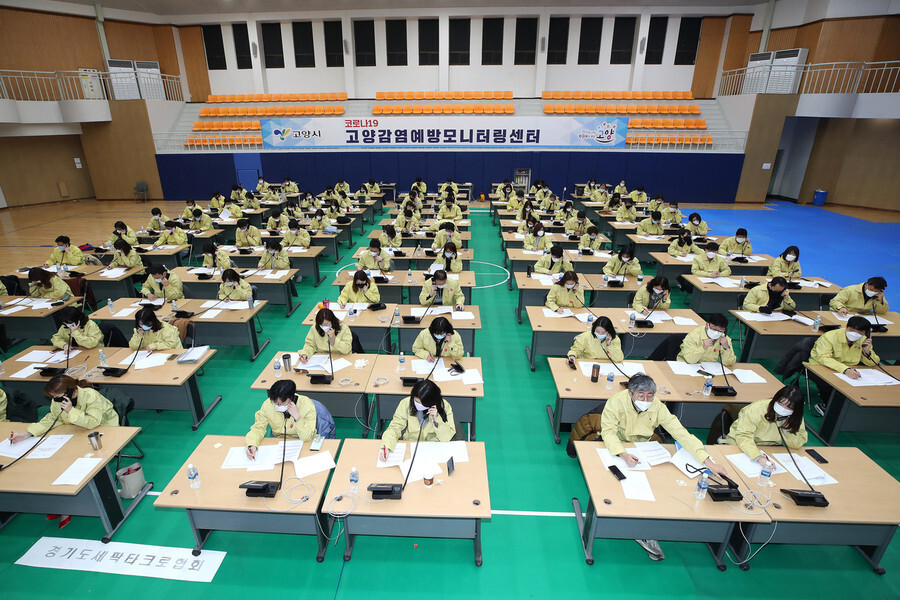hankyoreh
Links to other country sites 다른 나라 사이트 링크
Coronavirus cases among S. Korean women nearly double that of men

Figures show that women in their 20s account for a large percentage of the cases of COVID-19, the disease resulting from the novel coronavirus, in South Korea. This preponderance is thought to result from the large number of young women who are members of the Shincheonji religious sect, a nexus in the transmission of the disease. So far, the COVID-19 death rate in the country, which is calculated by dividing the number of cases by the number of deaths, is 0.6% overall, but the rate is considerably higher, at 5.4%, for those who are 80 years old and above.
South Korea’s Centers for Disease Control and Prevention (KCDC) released an analysis of the gender, age, and regional characteristics of COVID-19 patients, who numbered 4,812 as of Mar. 3. The most notable finding was that the number of female patients was nearly double that of male patients. There were 3,002 female patients, representing 62.4% of the total, compared to 1,810 male patients (37.6%).
People in 20s, 30s account for 41.4% of all infectionsA comparison of age groups also revealed some striking characteristics. There were 1,417 patients in their 20s (41.5%); 952 in their 50s (19.8%); 713 in their 40s (14.8%); 597 in their 60s (12.4%); 578 in their 30s (12%); 224 in their 70s (4.7%); 204 aged 10 to 19 (4%); 93 in their 80s and above (1.9%); and 34 under age 10 (0.7%). In short, people in their 20s and 30s accounted for 41.4% of the total.
“Women in their 20s and 30s make up a large portion of Shincheonji members,” the KCDC said. There are 2,698 cases linked to Shincheonji’s Daegu branch, representing 56.1% of all cases.
There were a total of 238 cases among minors (age 19 and under), representing 4.9% of the total. “Most of these patients were discovered not because they exhibited symptoms but because they were tested for family contact after their parents tested positive,” the KCDC said.
There are major differences in COVID-19 fatality rate by age group. First of all, there haven’t been any fatalities among minors and people in their 20s. The respective death rates for people in their 30s and 40s are 0.2% and 0.1%, lower than the overall average. But the death rate rose steadily after that, to 0.5% for those in their 50s, 1.2% for those in their 60s, 4% for those in their 70s, and 5.4% for those in their 80s and above.
“We can see that the death rate increases sharply as age increases, and especially for those above 80 years old. We’re reorganizing the healthcare services to prioritize reducing the fatality rate for high-risk groups, including the elderly and those with chronic conditions,” the KCDC said.
The KCDC also calculated the COVID-19 incidence rate per 100,000 people. The incidence rate in Daegu, the site of a mass outbreak concentrated on the local branch of the Shincheonji religious sect, was particularly high, with 126.5 testing positive for the virus per 100,000 people. The incidence rate in North Gyeongsang Province, which has seen several clusters of infection (including those at the Daenam Hospital in Cheongdo County and at a home for the disabled called Grain of Wheat House of Love in Chilgok), is 23.4 per 100,000. The rate in other areas is just 0.2 or 3.7 per 100,000.
As of Mar. 3, 12:00 am, the KCDC’s figures indicate a total of 4,812 cases and 29 deaths. “We’ve confirmed that one [Shincheonji] member entered the country from the Chinese city of Wuhan [where the outbreak began] on Jan. 8,” said the KCDC, which is tracking the source of the mass infection among Shincheonji members. But since the name of this member wasn’t on the list of those attending services, the KCDC is looking into whether transmission might have occurred through private interaction outside of the service. This member has reportedly not yet been tested for the disease.
By Lee Yu-jin, staff reporter
Please direct comments or questions to [english@hani.co.kr]

Editorial・opinion
![[Column] Life on our Trisolaris [Column] Life on our Trisolaris](https://flexible.img.hani.co.kr/flexible/normal/500/300/imgdb/original/2024/0505/4817148682278544.jpg) [Column] Life on our Trisolaris
[Column] Life on our Trisolaris![[Editorial] Penalties for airing allegations against Korea’s first lady endanger free press [Editorial] Penalties for airing allegations against Korea’s first lady endanger free press](https://flexible.img.hani.co.kr/flexible/normal/500/300/imgdb/original/2024/0502/1817146398095106.jpg) [Editorial] Penalties for airing allegations against Korea’s first lady endanger free press
[Editorial] Penalties for airing allegations against Korea’s first lady endanger free press- [Editorial] Yoon must halt procurement of SM-3 interceptor missiles
- [Guest essay] Maybe Korea’s rapid population decline is an opportunity, not a crisis
- [Column] Can Yoon steer diplomacy with Russia, China back on track?
- [Column] Season 2 of special prosecutor probe may be coming to Korea soon
- [Column] Park Geun-hye déjà vu in Yoon Suk-yeol
- [Editorial] New weight of N. Korea’s nuclear threats makes dialogue all the more urgent
- [Guest essay] The real reason Korea’s new right wants to dub Rhee a founding father
- [Column] ‘Choson’: Is it time we start referring to N. Korea in its own terms?
Most viewed articles
- 1New sex-ed guidelines forbid teaching about homosexuality
- 260% of young Koreans see no need to have kids after marriage
- 3OECD upgrades Korea’s growth forecast from 2.2% to 2.6%
- 4[Column] Life on our Trisolaris
- 5[Guest essay] Maybe Korea’s rapid population decline is an opportunity, not a crisis
- 6Presidential office warns of veto in response to opposition passing special counsel probe act
- 7S. Korea discusses participation in defense development with AUKUS alliance
- 8Two lung cancer deaths at Samsung Electronics deemed occupational in nature
- 9Trump asks why US would defend Korea, hints at hiking Seoul’s defense cost burden
- 10Inside the law for a special counsel probe over a Korean Marine’s death